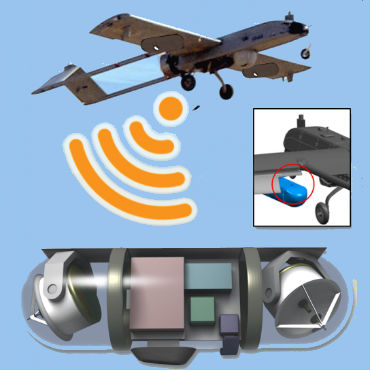DARPA explores drone-powered Wi-Fi

Research agency's program would put hotspots in the air to bring broadband to troops in the field -- much as Google is looking to do for consumers with its Titan Aerospace acquisition.

DARPA is using Iraq-war vintage RQ-7 Shadow surveillance drones to see if the small aircraft can carry the package of power supplies and hotspot components and also to see if they can communicate effectively with other ground-based and airborne hotspots.
Defense Department technology researchers are putting high-speed mobile hotspots on drones to carry long-range, high-capacity wireless hotspots over places where network access is scarce or absent.
The Defense Advanced Research Project Agency (DARPA) said in early April that it is making progress in providing 1 GB, 4G-like wireless millimeter wave backbone communications links to military units by mounting advanced hotspot gear to small unmanned aerial drones.
DARPA is using Iraq-war vintage RQ-7 Shadow surveillance drones to see if the small aircraft can carry the package of power supplies and hotspot components and also to see if they can communicate effectively with other ground-based and airborne hotspots. Ultimately, the agency is aiming for a nimble technology payload that is no wider than eight inches, weighs less than 20 pounds and uses less than 150 watts of power.
The mobile hotspot program, it said, is aimed at providing high-speed bandwidth to lower ranking echelons of troops in the field to connect to tactical operations centers with intelligence, surveillance and reconnaissance (ISR) data. The technology also has domestic potential, as well -- the Federal Emergency Management Agency, for example, has expressed interest in finding ways to quickly deploy communications networks when natural disasters have knocked out existing infrastructure.
The private sector is focused on drone-driven networks as well. Only a few days after DARPA detailed its efforts to develop flying hotspots, Google announced it was buying Titan Aerospace, a premier developer and builder of high-altitude drones. The company develops unmanned vehicles that can fly at the edge of the earth's atmosphere and can potentially carry transmission gear to support cheap, always-on Internet connectivity to far-flung places around the earth.
Titan calls its technology "atmospheric satellites." Google reportedly wants the technology to support its "Project Loon" global Internet connectivity plan. Project Loon, according to the Google's website, is a network of balloons traveling on the edge of space, designed to connect people in rural and remote areas, help fill coverage gaps, and bring people back online after disasters.
The Federal Aviation Administration is currently working on rules to govern the use of unmanned aerial systems in U.S. airspace. Those regulations are expected to be in place in 2015 -- one factor driving the broader commercial push into UAS technology.
According to DARPA, potential vendors under the mobile hotspots program recently completed the first of three technology development and testing phases, including technology integration and flight tests.
"We're pleased with the technical achievements we've seen so far in steerable millimeter-wave antennas and millimeter-wave amplifier technology," said Dick Ridgway, DARPA program manager. "These successes—and the novel networking approaches needed to maintain these high-capacity links—are key to providing forward deployed units with the same high-capacity connectivity we all enjoy over our 4G cell-phone networks."
NEXT STORY: From the Cloud to Your Pentagon-Issued Phone


